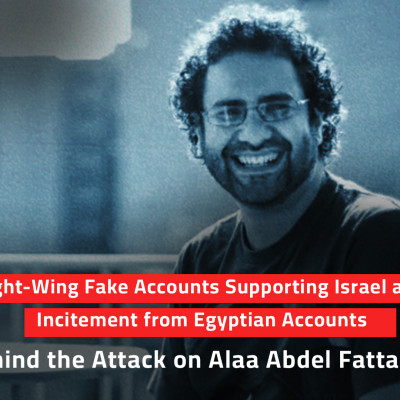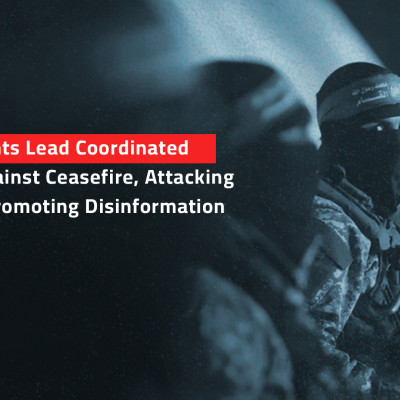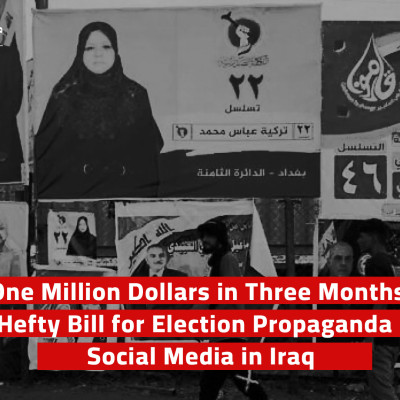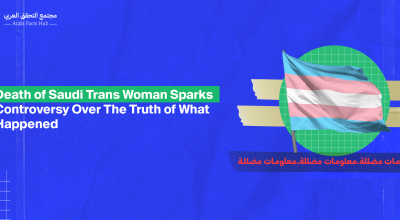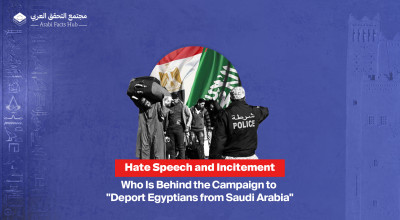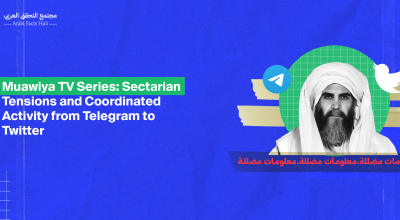What happened?
On the 22nd of August 2022, the STC in South Yemen launched the Siham Al Sharq/Siham Al Janoub operation under the pretext of "combating terrorism." Concurrently, officials from the internationally recognized Yemeni government accused the council of exploiting the terrorism narrative to eliminate remnants of the Yemeni army and extend its influence in oil-rich provinces.
In contrast, Al Islah Party, which is part of the government, challenged the STC that it can not exclude Al Islah and take control of its areas of influence in the southern provinces. The STC began its movements to consolidate control, but the pace accelerated in recent months, especially after the emergence of the Presidential Leadership Council led by Rashad Al Alimi, who succeeded President Abdrabbuh Mansur, currently in Riyadh. The council announced its formation in April 2022.
The unfolding events align with the ongoing discussions surrounding the Presidential Council's endeavors to assimilate STC forces into the Yemeni army, aligned with the official Yemeni government. The STC alleges that the army is under the influence of the Al Islah and asserts that its operations are geared towards implementing the provisions of the Riyadh Agreement. This includes the withdrawal of the "occupying" forces of the northern Yemeni army from the southern regions.
The pivot towards Abyan followed the STC's consolidation of control in Shabwa province. On the evening of August 22, the announcement of the Abyan operation coincided with well-coordinated online campaigns, orchestrated to electronically mobilize support for the military endeavors of the Southern Transitional Council.
The “Al Ghad Al Moshreq'' channel (Bright Tomorrow), established in August 2016 and backed by the UAE, is managed by individuals with residences between Egypt and the Emirates. The tv channel stands out as one of the most prominent media outlets interested in covering the STC's operations and in promoting its narrative.

A screenshot of the Transparency feature reveals that the administrators of the Al Ghad Al Moshreq’s Facebook page include three individuals based in Egypt and two in the UAE
In addition to its extensive television coverage, the channel engaged in mobilizing support through the hashtag #Eastern_Arrow (Siham Al Sharq), launched immediately upon the official announcement of operations. The hashtag reached its peak on the first day with over 4,000 tweets. The channel aimed to encourage others to utilize it. The hashtag became a 2020 phenomenon, with a total of 7,324 tweets and 48,866 retweets by November, along with over 173,999 likes.
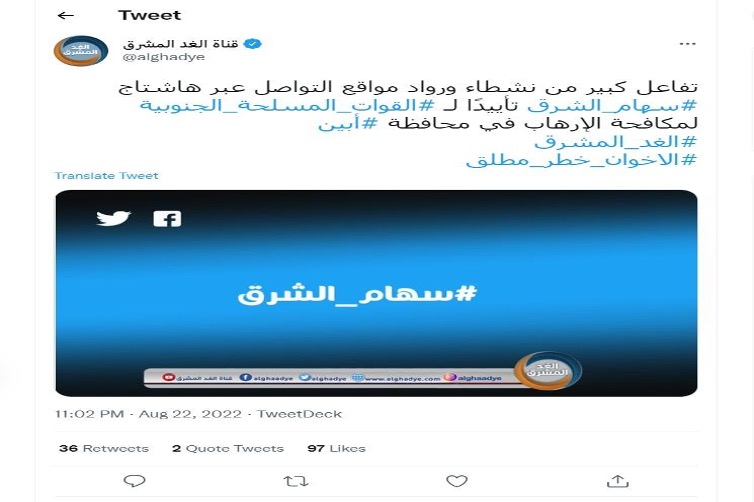
An SNA InVID graph depicts a sudden vertical spike in activity transitioning to a coordinated but non-escalating pattern, seemingly occurring spontaneously. The graph also illustrates how the level of retweets (blue) surpasses the tweet rate itself (orange), indicating organized activity.

Screenshot from InVID SNA tool showing the activity period of the hashtag #Eastern_Arrows.
Within media institutions, the most active presence under the hashtag was the account of "Aden Al Mustaqila," (Independent Aden) boasting 161,000 followers on Twitter, surpassing the usage of the #Eastern_Arrows hashtag. Alone, it published at least 282 tweets. It was followed by the account of "Al Youm Al Thamen '' newspaper, based in Aden, with 195 tweets, followed closely by Al Ghad Al Moshreq with 189 tweets from its account. Aden Al Mustaqila garnered the largest share of interactions, with its tweets being retweeted 9,732 times and receiving 25,917 likes.
In addition to media institutions, individual accounts also constituted a significant share of interactions. Among them was Wadah Bin Atiya, who identifies himself on Twitter as a member of the Southern National Assembly and one of the members of the Riyadh Consultations delegation. Wadah, whose tweets were retweeted 1,394 times and liked 5,714 times, played a significant role in advocating and mobilizing support for the STC. His account is followed by over 230,000 people on Twitter and nearly 40,000 on Facebook. Wadah contributed to the launch of another hashtag in English #SouthYemenFightsTerrorism, aiming to "voice the Southern cause to the world." The hashtag garnered 395 tweets, over 2,500 retweets, and 7,412 likes. However, the hashtag wasn’t very impactful seeing as the English hashtag had tweets exclusively in the Arabic language.
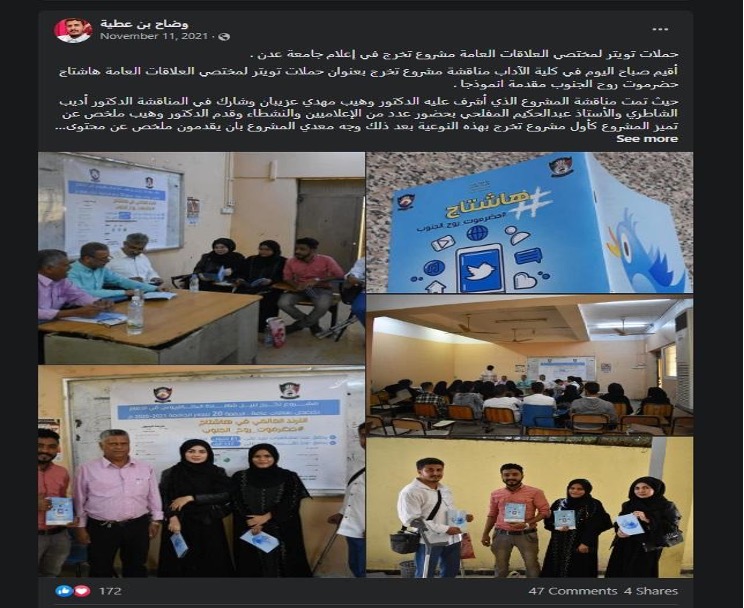
Wadah is known for launching hashtags and inviting Southerners to tweet using the hashtags he suggests, some of which targeted the internationally recognized Yemeni government currently based in Aden (#Legitimacy_Obstructs_Riyadh_Agreement).
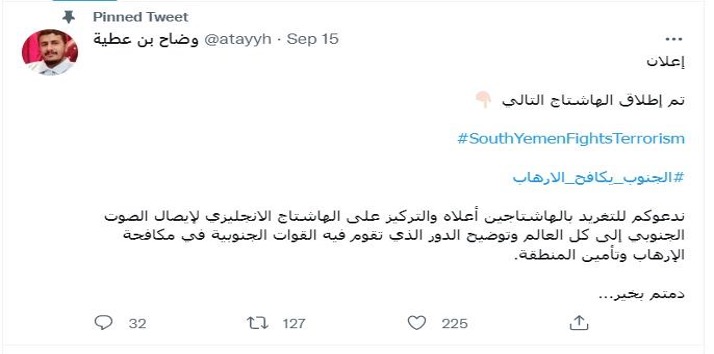
He was also part of the tweeting campaign under the hashtag #Emirati_Development_Projects_In_The_South, last March.

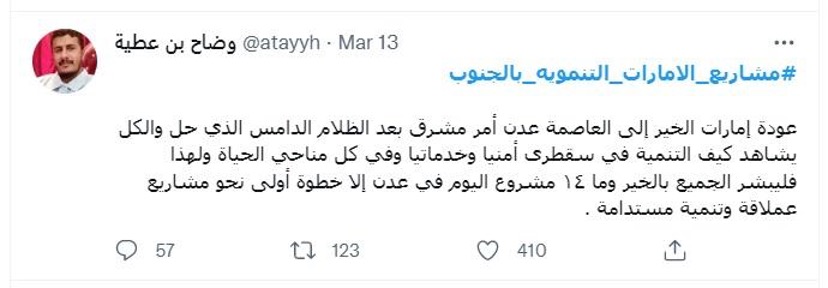
According to analysis using the Hashtagify tool, the participation rate from Saudi Arabia through the #Eastern_Arrows hashtag exceeded 47. This explains the hashtag’s prominence and its appearance in the list of the most trending topics in Saudi Arabia during peak periods. The participation rate in Saudi Arabia was higher than in Yemen (30%), while the United States accounted for 20% of participation.
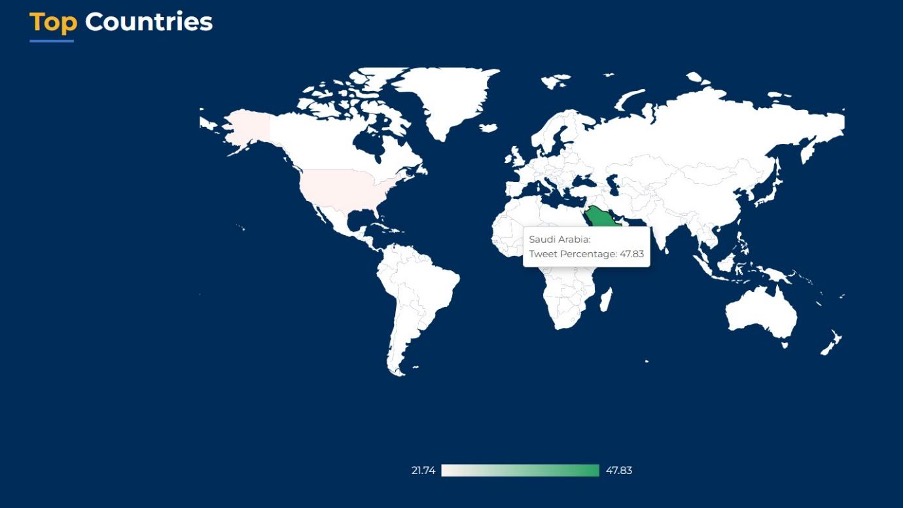
Hadhramaut
STC adopted "Fighting Terrorism" as a primary slogan for its military campaign to expand its presence in the south. Additionally, its supporters used the same argument to support its efforts in deploying units such as the "Security Belt" and the "Hadrami Elite," well-trained armed forces receiving significant support from the UAE.
The tweets focused on attacking the "Islah Party," accusing it of aiding both Al Qaeda and the Houthi group, which controls Sanaa and northern Yemen. They also demanded the withdrawal of the "occupation" from the south, referring to the Yemeni army units in the southern provinces. Moreover, they aimed to prepare the rest of the southern population for similar deployments in Al Mahra and Hadhramaut, following the takeover of the provinces of Shabwa and Abyan, whether through Twitter or through ground marches supportive of the STC in these provinces.
The hashtag #Hadhramaut_Southern_Region_Rejects_The_Brotherhood (in reference to Al Islah) emerged in mid September. Total tweets on the hashtag reached 3,475, with 12,300 retweets and 35,000 likes.

We noticed the following post in a group named after the STC, comprising more than 100,000 members. AbdulKarim Maqram, followed by 17,000 people, shared designs and posters containing phrases resembling organized messages directed towards adversaries and residents of the provinces the STC intends to enter.
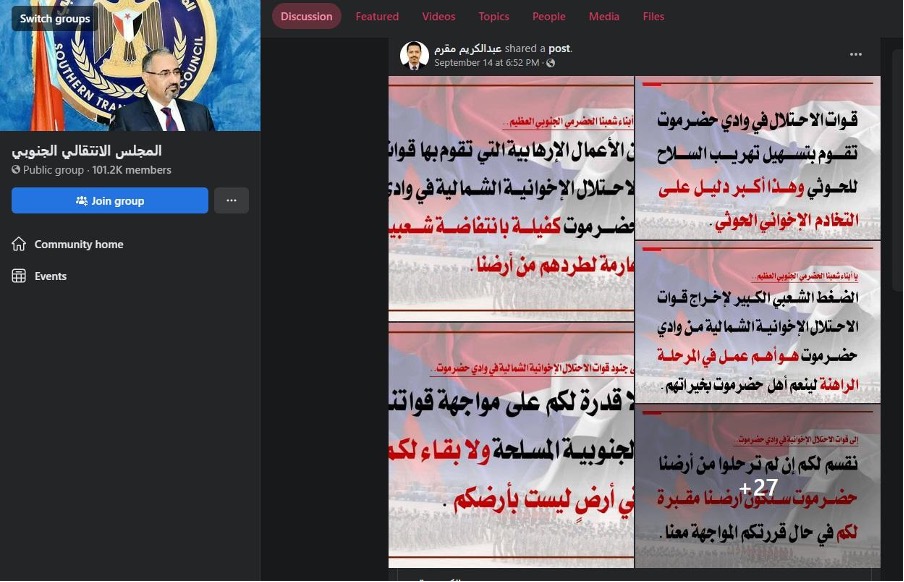
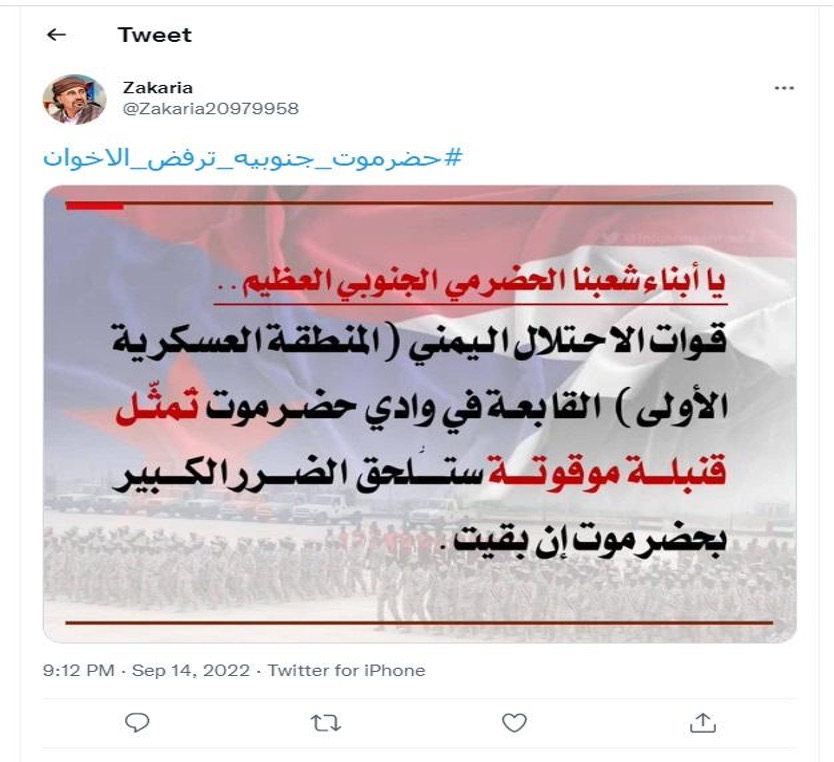
According to Gephi, the account of the channel Aden Al Mustaqila (shown in purple in the graph below) dominated about 20% of interactions on the #Hadhramaut_Southern_Region_Rejects_The_Brotherhood hashtag. The STC subordinate channel emerged after the establishment of the Council in 2019 and is supervised by the National Media Authority in southern Yemen.
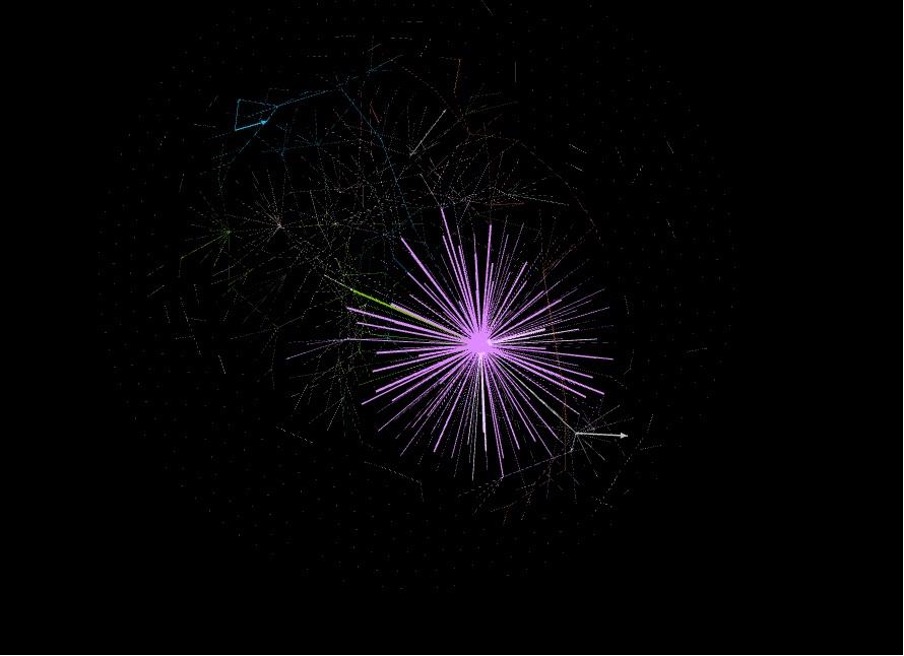
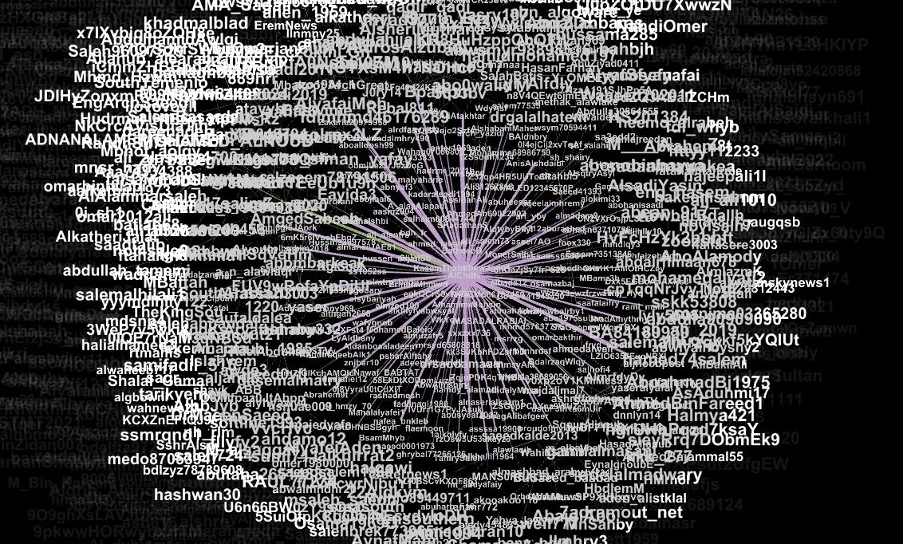
Two days before the launch of the Eastern Arrows operation, STC supportive newspaper, "Aden Al Ghad," managed by individuals in Yemen and Saudi Arabia, stated that an Egyptian team took over the channel's management at the beginning of last August, under the supervision of STC activist Abdulaziz Al Sheikh, who has ties to UAE leadership as well as STC leaders.
Al Islah Party Responds
We have noticed that the virtual response from supporters of the Islah Party typically comes with a delay. For instance, response to the #Eastern_Arrows operation lagged behind by at least two weeks from the launch of the military and online campaigns.
Some of Al Islah’s supportive hashtags included:
#Islah_Yemen_Unites_Us: 5036 tweets, 10101 retweets, 53701 likes
#Bin_Zayed_Official_Sponsor_of_Terrorism: 2626 tweets, 10251 retweets, 46590 likes
#STC_ISIS_of_the_South: 2535 tweets, 9589 retweets, 56758 likes
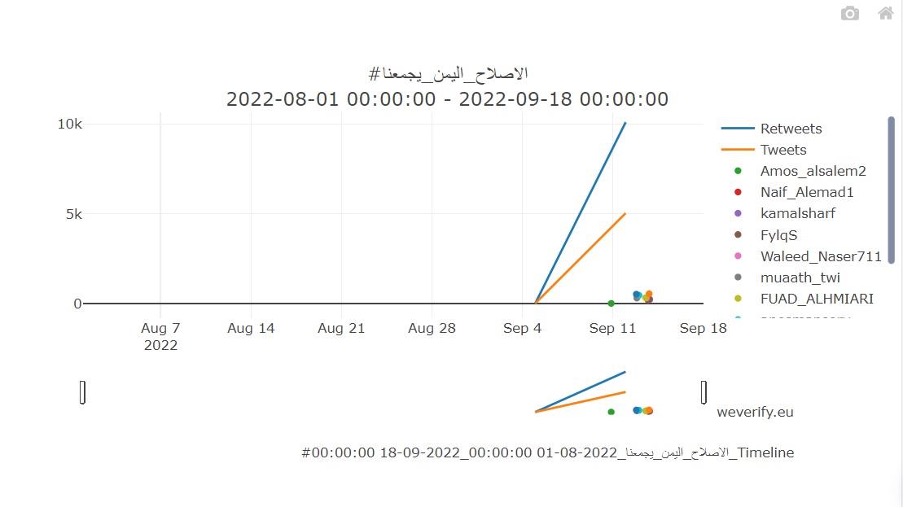
The "Suhail" satellite channel's account stood out, supporting the discourse of the Islah Party and managed by seven individuals residing in Saudi Arabia, who were among the prominent accounts participating in the #Islah_Yemen_Unites_Us hashtag. This hashtag was launched before the party's anniversary celebration and was used to support its position against the STC.
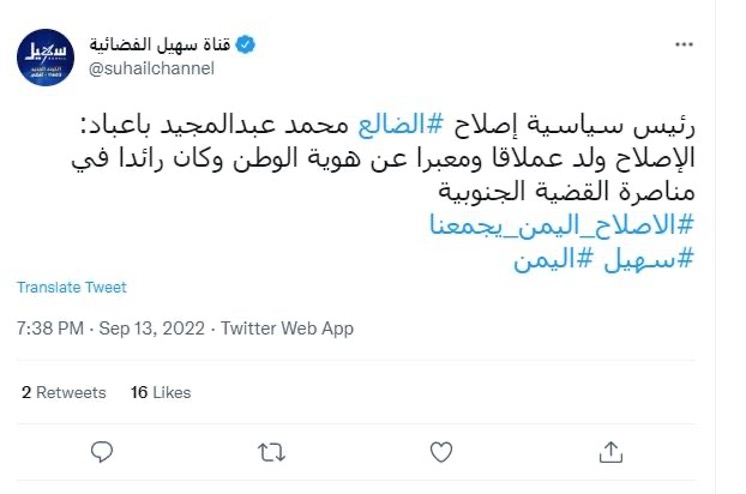
A common denominator among the three hashtags was the prominent role of the journalist Anis Mansour Al Sabaihi (@anesmansory), head of the studies center and the electronic newspaper "Hona Aden," which supports the Islah Party. Al Sabaihi, who previously served as a media advisor in the Yemeni Ministry of Foreign Affairs, has over 397 thousand followers. He currently resides in Istanbul, as indicated by data from his personal Facebook account, while his page is managed by five individuals in Oman. Al Sabaihi plays a role that is similar to that of Wadah Bin Attiya, in terms of launching hashtags and inviting his followers on Facebook to participate in tweeting using the hashtags on Twitter.
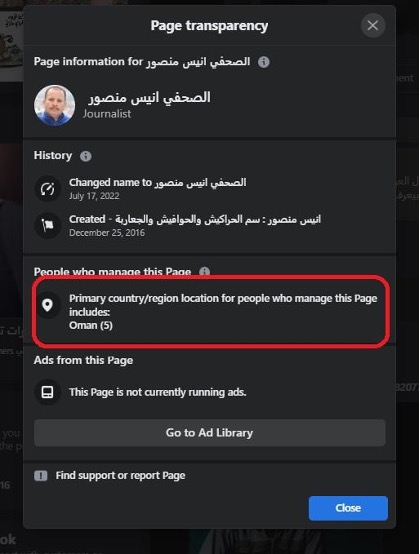
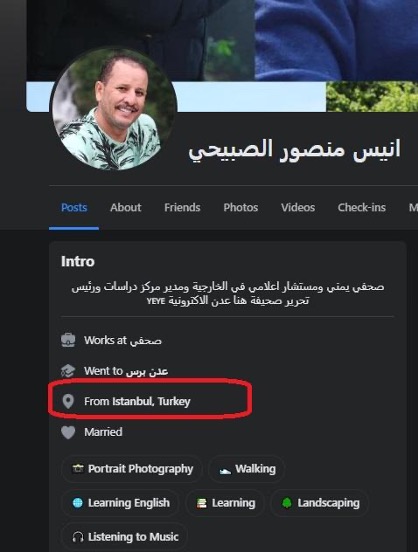
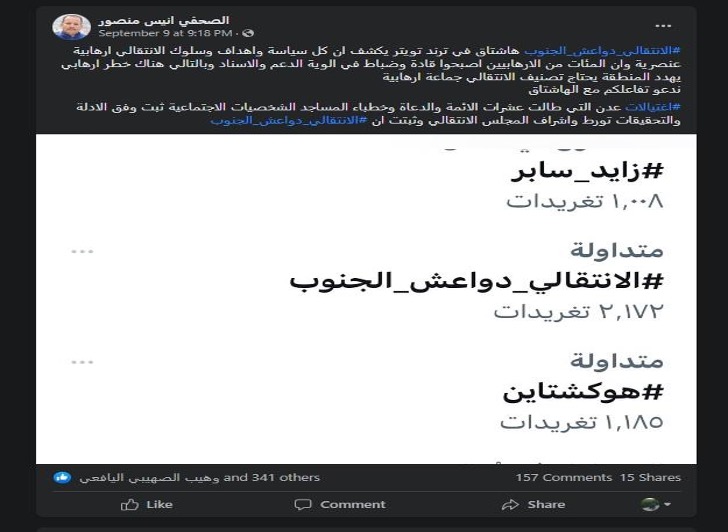
Despite Yemen's geographical proximity to the Gulf region and the Arabian Peninsula, Facebook is more popular among the country's inhabitants, unlike Twitter, which is more commonly used in neighboring countries.
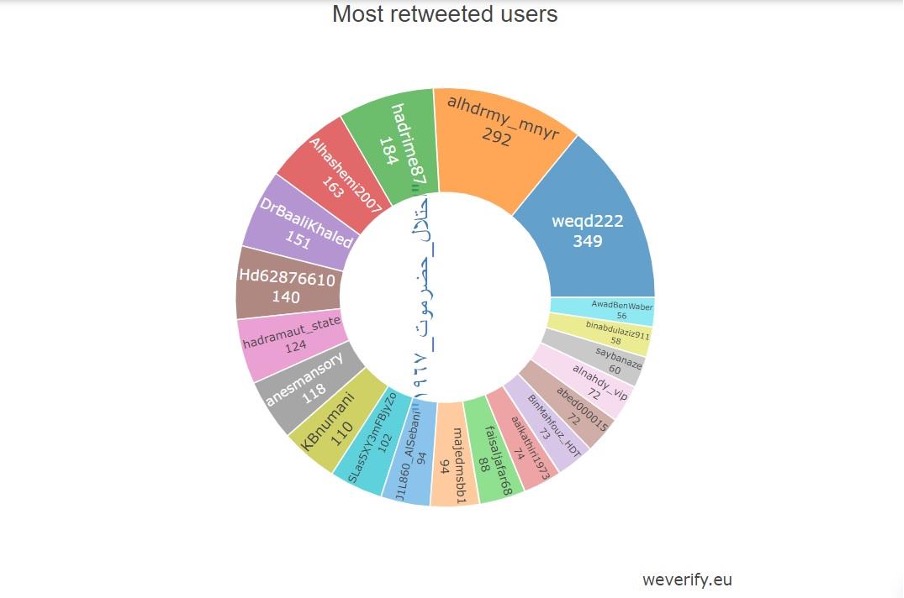
Posts from accounts sympathetic to the Hadhramaut region emerged, recalling its past during the Sultanate rule and what happened afterward. Many of these individuals shared images of the separatist flag of Hadhramaut or the independent state of Hadhramaut, as hoped for after independence. Participants likened the situation in Hadhramaut to that of 1967 and rejected the region becoming a battleground for Yemeni factions. They did not want "Zaydis," referring to the Zaidi Shia sect in northern Yemen, or "Lahjis," referring to the Lahij province which is influential, alongside Aden, in decision-making in the south.
This rejection was reflected in other hashtags calling for secession, including #State_of_Hadhramaut and #Hadhramaut_Rejects_Zaydis_and_Lahjis, indicating a third stance that does not lean towards the Islah Party, supporters of Yemeni unity, or the STC, which seeks to achieve the dream of a South Yemeni state.

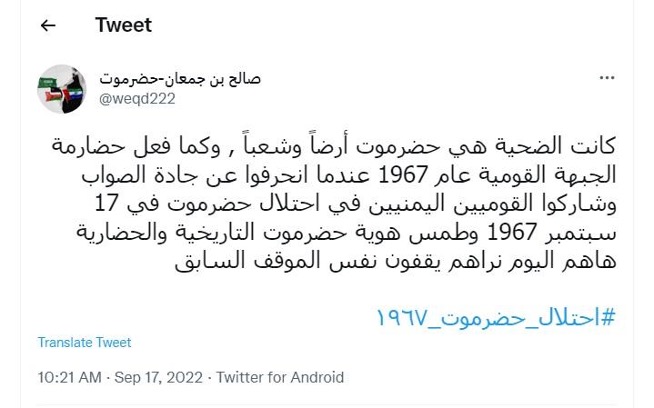

In conclusion, several key points can be drawn from this research:
- The competition between factions in southern Yemen has shifted to the virtual space in the form of hashtags or directed reports on websites.
- There were comprehensive and largely organized online campaigns whose goals evolved and changed according to developments on the ground. After the Southern Transitional Council's control over Abyan, there were preparations and groundwork for the people of Hadhramaut as the next destination for the STC’s forces.
- These campaigns relied on hashtags and social media platforms in addition to real-time news coverage and directed television broadcasts, such as the case of the Aden Al Mustaqila channel which is affiliated with the STC.
In contrast, there was the "Suhail" channel supportive of the Islah Party.
- The materials used in promoting political discourse garnered significant attention. There were channels with appealing appearances beyond the usual, including posters and visually appealing graphics.
- The hashtags benefited from the dominance of the polarizing positions of the conflicting parties, which helped increase the volume of activity from their supporters.
- The online performance of STC supporters appeared organized, demonstrating their adeptness in using social networks.
- These campaigns were focused on Twitter, despite Facebook's popularity in Yemen, as the actors in the campaigns realized that the path to influence lies through Twitter.
- There were still attempts to mobilize participants initially through Facebook groups or through social media influencers with large following, inviting them to move from Facebook to Twitter and contribute to tweeting using the hashtags.
Tools ustilized:
InVID Verification Plugin
Twitter Search
Tweetdeck
Hashtagify
Gephi

